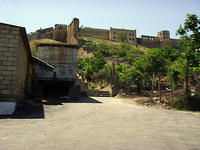You are in: Europe -> Russia -> Citadel, Ancient Cit... , and traditional search or Image Gallery will yield results of this site only
Citadel, Ancient City and Fortress Buildings of Derbent
| Site number: | 1070 |
|
| Type of site: | Cultural | |
| Date: | Siglo 19 | |
| Date of Inscription: | 2003 | |
| Location: | Eurasia, Russian Federation, Western coast of Caspian Sea, Eastern Caucasus, Dagestan, Citadel | |
Up to 75 images are shown here. Click on each for more details or on Image Gallery for more images.
| Description: | On the East and west of the Caspian Sea the Citadel, Ancient City and Fortress Buildings of Derbent extend as part of the northern lines of the Sasanian Persian Empire. The stone built fortification consists of two parallel walls that shaped an obstruction from the seashore up to the mountain. Retaining part of its medieval fabric, the town of Derbent was erected between these two walls. The site remained to hold a great strategic importance until the 19th century. --WHMNet paraphrase from the description at WHC Site, where additional information is available. | |
| Derbent (Russian: Дербе́нт; Azeri: Dərbənd; Lezgi: Дербент; Avar: Дербенд; Persian: دربند, Darband) is a city in the Republic of Dagestan, Russia. It is the southernmost city in Russia, and it is the second most important city of Dagestan. The Azeris are the main ethnic group, followed by Lezgins and Tabasarans. Often identified with the legendary Gates of Alexander, Derbent claims to be the oldest city in the Russian Federation. Since antiquity the value of the area as the gate to the Caucasus has been understood and Derbent has archaeological structures over 5,000 years old. As a result of this geographic particularity the city developed between two walls, stretching from the mountains to the sea. These fortifications were continuously employed for a millennium and a half, longer than any other extant fortress in the world. Over the years different nations gave the city different names, but all connected to the word 'gate'. Derbent has a unique strategic location in the Caucasus: the city is situated on a thin strip of land (three kilometres) between the Caspian Sea and the Caucasus mountains. Historically, this position allowed the rulers of Derbent to control land traffic between south-eastern Europe and the Middle East. The first intensive settlement in the Derbent area dates from the 8th century BCE; the site was intermittently controlled by the Persian monarchs, starting from the 6th century BCE. Until the 4th century CE it was part of Caucasian Albania, and is traditionally identified with Albana, the capital. The modern name is a Persian word (دربند Darband) meaning "closed gates", which came into use in the end of the 5th or the beginning of the 6th century AD, when the city was refounded by Kavadh I of the Sassanid dynasty of Persia. The twenty-metre-high walls with thirty north-looking towers are believed to belong to the time of Kavadh's son, Khosrau I of Persia. The Armenian chronicler Movses Kagankatvatsi wrote about "the wondrous walls, for whose construction the Persian kings exhausted our country, recruiting architects and collecting building materials with a view of constructing a great edifice stretching between the Caucasus Mountains and the Great Eastern Sea". Derbent became a strong military outpost and harbour of the Sassanid empire. During the 5th and 6th centuries Derbent becomes also an important centre for spreading the Christian faith in the Caucasus. Derbent being in practice a huge museum and with magnificent mountains and shore nearby, a great potential for development of the tourism industry exists, further increased by UNESCO's classification of the Citadel, Ancient City and Fortress as a World Heritage Site in 2003; however, instability in the region has not allowed further development. --Wikipedia. Text is available under the Creative Commons Attribution-ShareAlike License. | ||
| Source: | http://whc.unesco.org/en/list/1070 | |
| Reference: | 1. UNESCO World Heritage Center, Site Page. | |
















